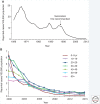Epidemiology and Transmission of Hepatitis A Virus and Hepatitis E Virus Infections in the United States
- PMID: 29712684
- PMCID: PMC6444696
- DOI: 10.1101/cshperspect.a033431
Epidemiology and Transmission of Hepatitis A Virus and Hepatitis E Virus Infections in the United States
Abstract
There are many similarities in the epidemiology and transmission of hepatitis A virus (HAV) and hepatitis E virus (HEV) genotype (gt)3 infections in the United States. Both viruses are enterically transmitted, although specific routes of transmission are more clearly established for HAV than for HEV: HAV is restricted to humans and primarily spread through the fecal-oral route, while HEV is zoonotic with poorly understood modes of transmission in the United States. New cases of HAV infection have decreased dramatically in the United States since infant vaccination was recommended in 1996. In recent years, however, outbreaks have occurred among an increasingly susceptible adult population. Although HEV is the most common cause of acute viral hepatitis in developing countries, it is rarely diagnosed in the United States.
Copyright © 2019 Cold Spring Harbor Laboratory Press; all rights reserved.
Figures


References
-
- Amon JJ, Devasia R, Xia G, Nainan OV, Hall S, Lawson B, Wolthuis JS, Macdonald PD, Shepard CW, Williams IT, et al. 2005. Molecular epidemiology of foodborne hepatitis A outbreaks in the United States, 2003. J Infect Dis 192:1323–1330. - PubMed
-
- Amon JJ, Drobeniuc J, Bower WA, Magaña JC, Escobedo MA, Williams IT, Bell BP, Armstrong GL. 2006. Locally acquired hepatitis E virus infection, El Paso, Texas. J Med Virol 78: 741–746. - PubMed
-
- Ankcorn MJ, Tedder RS. 2017. Hepatitis E: The current state of play. Transfus Med 27: 84–95. - PubMed
-
- Azimi PH, Roberto RR, Guralnik J, Livermore T, Hoag S, Hagens S, Lugo N. 1986. Transfusion-acquired hepatitis A in a premature infant with secondary nosocomial spread in an intensive care nursery. Am J Dis Child 140: 23–27. - PubMed
Publication types
MeSH terms
Substances
LinkOut - more resources
Full Text Sources
Other Literature Sources
Medical
Miscellaneous
